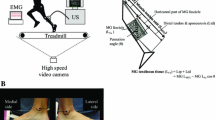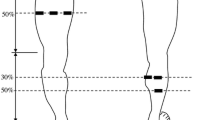Abstract
The purpose of this study was to investigate the elastic properties of muscle-tendon complex (MTC) in knee extensor muscles and the capacity for elastic energy utilization in long-distance runners (LDR) by comparing with data obtained from untrained individuals (CON). The elongation (L) of the tendon and aponeurosis of vastus lateralis muscle during isometric knee extension was determined by real-time brightness mode ultrasonography, while the subjects developed a gradually increasing torque from 0 (relaxed) to maximal effort (MVC) within 7 s. In addition, performances in two kinds of maximal vertical jumps, i.e. squatting (SJ) and counter-movement jumps (CMJ), were measured. The relationship between L muscle and force (F ) was curvilinear and consisted of an initial region (toe region), characterized by a large increase in L with increasing F, immediately followed by a linear region. The slope of the regression equation for the L-F relationship in the range 50%–100% of MVC was defined as an index of MTC compliance, where the rate of the changes in L to that in muscle F at every 10% of MVC became almost constant. The maximal L (L max) and MTC compliance were significantly lower in LDR than in CON: 29.9 (SD 3.9) mm in LDR compared to 33.3 (SD 5.5) mm in CON for L max and 1.55 (SD 0.25) × 10−2 mm · N−1 in LDR compared to 1.88 (SD 0.82) × 10−2 mm · N−1 in CON for MTC compliance. Also, LDR showed significantly less elastic energy absorption (E e) than CON, defined as the area below the L-F relationship curve from 0 to 100% of MVC. Not only jump heights but also the differences between the heights in SJ and CMJ, expressed as the percentage of the height in SJ, were significantly lower in LDR than in CON. The augmentation with counter-movement was significantly correlated to either MTC compliance (r = 0.554, P < 0.05) or E e (r = 0.563, P < 0.05). Thus, the present results would indicate that MTC of vastus lateralis muscle is less compliant and its potential for energy storage during MTS lengthening is lower in LDR than untrained individuals. These elastic profiles of vastus lateralis muscle in LDR may be associated with their lower performances during CMJ.
Similar content being viewed by others
Author information
Authors and Affiliations
Additional information
Accepted: 3 September 1999
Rights and permissions
About this article
Cite this article
Kubo, K., Kanehisa, H., Kawakami, Y. et al. Elastic properties of muscle-tendon complex in long-distance runners. Eur J Appl Physiol 81, 181–187 (2000). https://doi.org/10.1007/s004210050028
Issue Date:
DOI: https://doi.org/10.1007/s004210050028




